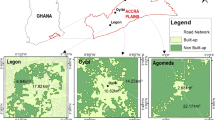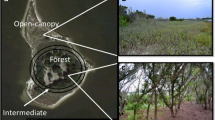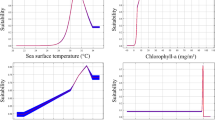Summary
There was no difference in home range size between supplementally fed and unfed lizards even though supplementally fed lizards gained significantly more body mass than did unfed lizards. A logistic growth model was fit to curves of accumulative home range size against days of observation for fed and unfed lizards. An analysis of these curves showed that supplementally fed lizards's home range estimates grew at a slower rate than did unfed lizards. Thus, fed lizards utilized the habitat at a slower rate than did unfed lizards. Moreover, the rate at which fed lizards utilized the habitat was linearly related to their increase in body mass. Supplementally fed male and unfed lizards of both sexes were equally active through the summer. On average, they were active on one out of every two days (49.4%), whereas, supplementally fed females were active on a significantly greater number of days (83.9%).
Similar content being viewed by others
References
Box GEP, Hunter WG, Hunter JS (1978) Statistics for experimenters. John Wiley and Sons
Carpeter FL, MacMillen RE (1976) Threshold model of feeding territoriality and test with a Hawaiian honeycreeper. Science 194:639–642
Derickson WK (1976) Lipid storage and utilization in reptiles. Amer Zool 16:711–723
Ebersole JP (1980) Food density and territory size: an alternative model and a test on the reef fish Eupomacentrus leucostictus. Am Nat 115:492–509
Ewald PW, Carpenter FL (1978) Territorial responses to energy manipulations in the Anna hummingbird. Oecologia (Berl) 31:277–292
Fox SF (1978) Natural selection on behavioral phenotypes of the lizard Uta stansburiana. Ecology 59:834–847
Fox SF, Rose E, Myers R (1981) Dominance and the acquisition of superior home ranges in the lizard Uta stansburiana. Ecology 62:888–893
Franzblau MA, Collins JP (1980) Test of a hypothesis of territory regulation in an insectivorous bird by experimentally increasing prey abundance. Oecologia (Berl) 46:164–170
Gass CL (1979) Territory regulation, tenure, and migration in rufous hummingbirds. Can J Zool 57:914–923
Gill FB, Wolf LL (1975) Economics of feeding territoriality in the golden-winged sunbird. Ecology 56:333–345
Hahn WE (1964) Seasonal changes in testicular and epididymal histology and spermatogenic rate in the lizard Uta stansburiana stejnegeri. J Morph 115:447–460
Hahn WE, Tinkle DW (1965) Fat body cycling and experimental evidence for its adaptive significance to ovarian follicle development in the lizard Uta stansburiana. J Exp Zool 158:79–86
Hilden O (1965) Habitat selection in birds. Annal Zool Fenn 2:53–75
Hixon MA (1980) Food production and competitor density as the determinants of feeding territory size. Am Nat 115:510–530
Hixon MA (1981) An experimental analysis of territoriality in the California reef fish Embiotoca jacksoni (Embiotocidae). Copeia 1981:653–665
Holmes RT (1970) Differences in population density, territoriality, and food supply of dunlin on arctic and subarctic tundra. pp 303–317. In: Animal populations in relation to their food resources. Watson A (ed.). Blackwell Press
Jennrich RI, Turner FB (1969) Measurement of non-circular home range. J Theor Biol 22:227–237
Krebs JR (1971) Territory and breeding density in the Great Tit Paris major. Ecology 52:2–22
Maiorana VC (1978) Difference in diet as an epiphenomenon: space regulates salamanders. Can J Zool 56:1017–1025
Mares MA, Watson MD, Lacher, Jr. TE (1976) Home range pertubations in Tamias striatus: food supply as a determinant of home range and density. Oecologia (Berl) 25:1–12
Mares MA, Lacher, Jr., TE, Willig MR, Bitar NA, Adams R, Klinger A, Tazik D (1982) An experimental analysis of social spacing in Tamias striatus. Ecology 63:267–273
Miller GR, Watson A, Jenkins D (1970) Responses of red grouse populations to experimental improvement of their food. pp. 323–334. In: Animal populations in relation to their food resources. Watson A (ed.). Blackwell Press
Olive CW (1982) Behavioral response of a sit-and-wait predator to spatial variation in foraging gain. Ecology 63:912–920
Parker WS, Pianka ER (1975) Comparative ecology of populations of the lizard Uta stansburiana. Copeia 1975:615–632
Porter WP, Mitchell JW, Beckman WA, DeWitt CB (1973) Behavioral implications of mechanistic ecology: thermal and behavioral modeling of desert ectotherms and their microenvironment. Oecologia (Berl) 13:1–54
Riechert SE, Tracy CR (1975) Thermal balance and prey availability: bases for a model relating web-site characteristics to spider reproductive success. Ecology 56:265–284
Rose B (1981a) Factors affecting activity in Sceloporus virgatus. Ecology 62:706–716
Rose B (1981b) Activity and reproduction in iguanid lizards. Ph.D. Diss. Univ. Calif. Riverside, Calif.
Rose B (1982) Lizard home ranges: methodology and functions. J Herpet 16:253–269
Roughgarden J, Porter WP, Heckel D (1981) Resource partitioning of space and its relationship to body temperature in Anolis lizard populations. Oecologia (Berl) 50:256–264
Schoener TW (1968) Sizes of feeding territories among birds. Ecology 49:123–141
Seastedt TR, MacLean SF (1979) Territory size and composition in relation to resource abundance in lapland longspurs breeding in arctic Alaska. Auk 96:131–142
Simon CA (1975) The influence of food abundance on territory size in the iguanid lizard Sceloporus jarrovi. Ecology 56:993–998
Slaney PA, Northcote TG (1974) Effects of prey abundance on density and territorial behavior of young rainbow trout (Salmo gairdneri) in laboratory stream channels. J Fish Res Board Can 31:1201–1209
Stamps JA, Tanaka S (1981) The relationship between food and social behavior in juvenile lizards (Anolis aeneus). Copeia 1981:422–434
Stenger J (1958) Food habits and available food of ovenbirds in relation to territory size. Auk 75:335–346
Stickel LF (1954) A comparison of certain methods of measuring ranges of small mammals. J Mammal 35:1–15
Stimson J (1973) The role of the territory in the ecology of the intertidal limpet Lottia gigantea (Gray). Ecology 54:1020–1030
Symons PEK (1971) Behavioural adjustment of population density to available food by juvenile atlantic salmon. J Anim Ecol 40:569–587
Tinkle DW (1967) The life and demography of the side-blotched lizard Uta stansburiana. Misc Pub Mus Zool Univ Mich No. 132
Turner FB, Jennrich RI, Weintraub JD (1969) Home ranges and body size of lizards. Ecology 50:1076–1081
Turner FB, Medica PA, Smith DD (1973) Reproduction and survivorship of the lizard Uta stansburiana, and the effects of winter rainfall, density and predation on these processes. US/IBP Des Biome Res Memo RM 73-26
Turner FB, Medica PA, Kowalewsky BW (1976) Energy utilization by a desert lizard (Uta stansburiana). US/IBP Des Biome Mono No. 1
Waldschmidt SR (1979) The effect of statistically based models on home range size estimate in Uta stansburiana. Am Midl Nat 101:236–240
Waldschmidt SR, Tracy CR Interactions between a lizard and its thermal environment: implications for sprint performance and space utilization in the lizard Uta stansburiana. Ecology (In Press)
Wise DH (1975) Food limitation of the spider Linyphia marginata: experimental field studies. Ecology 56:637–646
Wise DH (1979) Effects of an experimental increase in prey abundance upon reproductive rates of two orb-weaving spider species (Araneae: Araneidae). Oecologia (Berl) 41:289–300
Zar JH (1974) Biostatistical analysis. McElroy WD, Swanson CP (eds) Prentice Hall, Englewood Cliffs, New Jersey, USA
Author information
Authors and Affiliations
Rights and permissions
About this article
Cite this article
Waldschmidt, S. The effect of supplemental feeding on home range size and activity patterns in the lizard Uta stansburiana . Oecologia 57, 1–5 (1983). https://doi.org/10.1007/BF00379553
Received:
Issue Date:
DOI: https://doi.org/10.1007/BF00379553




